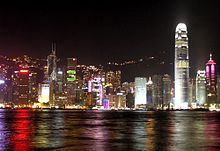Skyline: Difference between revisions
No edit summary |
it need not be a silhouette |
||
| Line 3: | Line 3: | ||
<!--NOTE: PLEASE DO NOT ADD LISTS OR PICTURES OF CITIES OR SKYLINES WITHOUT DISCUSSION ON TALK PAGE---> |
<!--NOTE: PLEASE DO NOT ADD LISTS OR PICTURES OF CITIES OR SKYLINES WITHOUT DISCUSSION ON TALK PAGE---> |
||
A '''skyline''' is best described as the overall or partial view |
A '''skyline''' is best described as the overall or partial view of a [[City|city's]] tall buildings and structures consisting of many [[skyscrapers]] in front of the sky in the background. It can also be described as the artificial [[horizon]] that a city's overall structure creates. Skylines serve as a kind of [[fingerprint]] of a city, as no two skylines are alike. For this reason news and sports programs, television shows, and movies often display the skyline of a city to set location. |
||
Paul D. Spreiregen, [[FAIA]], has called a skyline "a physical representation [of a city's] facts of life ... a potential work of art ... its collective vista."<ref>{{cite book |
Paul D. Spreiregen, [[FAIA]], has called a skyline "a physical representation [of a city's] facts of life ... a potential work of art ... its collective vista."<ref>{{cite book |
||
Revision as of 20:36, 23 June 2009

A skyline is best described as the overall or partial view of a city's tall buildings and structures consisting of many skyscrapers in front of the sky in the background. It can also be described as the artificial horizon that a city's overall structure creates. Skylines serve as a kind of fingerprint of a city, as no two skylines are alike. For this reason news and sports programs, television shows, and movies often display the skyline of a city to set location.
Paul D. Spreiregen, FAIA, has called a skyline "a physical representation [of a city's] facts of life ... a potential work of art ... its collective vista."[1]
In general, larger cities have broader and taller skylines, though lower density cities often have smaller skylines than expected for city size. Taller buildings are found where either land value or desire for visibility is higher, and the tallest buildings in a city are usually office buildings. Because of this, the skyline of a city can be seen as symbolic of the city's influence and economy.
References
- ^ Paul D. Spreiregen (1965). Urban Design: The Architecture of Towns and Cities. McGraw-Hill.
External links
- Di Serio's top 15 Skylines
- The Skyline Project has a collection of skyline photographs from across the United States.
- The World's Best Skylines calculates ranking by height and breadth of skylines.
- All About Skyscrapers
- Tallest Cities of the World calculated ranking strictly by height.
- Emporis ranking of cities by the visual impact of their skylines
- Skyline on m-w.com
